Teaching Files
Case 14
Contributed by: Steven J. Rockoff, MD and Diana L. Lam, MD - June 1, 2020
A 40-year-old woman presents for a baseline screening mammogram:
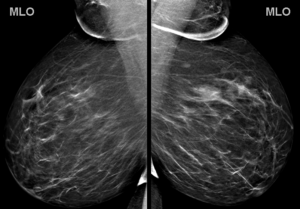
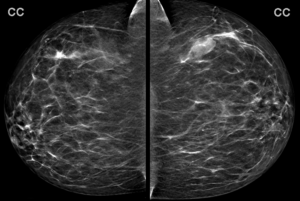
You note a large mass in the left breast. What is the best description for the location of this mass?
A. 1:00 (upper outer quadrant)B. 1:00 (upper inner quadrant)
C. 5:00 (lower outer quadrant)
D. 5:00 (lower inner quadrant)
E. 11:00 (upper inner quadrant)
F. 11:00 (upper outer quadrant)
Explanation: To interpret a mammogram, one must become familiar with the proper way to describe the location of a finding such as a mass or calcifications. Standard reporting should include the following:
- Laterality (left or right breast)
- Quadrant (upper outer, upper inner, lower outer, or lower inner)
- O’clock face (i.e. 12:00, 1:00, 2:00, etc…)
O’clock face is determined by visualizing that you are standing in front of the patient, looking at the breast with a clock superimposed upon it. Note that any o’clock position will not be in the same quadrant of each breast (i.e. a 2:00 mass in the right breast is upper inner quadrant, but a 2:00 mass in the left breast is upper outer quadrant).
As per the ACR BI-RADS manual, other location descriptors that can be used are:
- Depth (anterior third, middle third, or posterior third)
- Distance from the nipple
- A few terms that can be used in lieu of a quadrant: “central”, “retroareolar”, “axillary tail”
Determining the quadrant and o’clock face of a finding requires being familiar with the standard display of a mammogram. If you are not yet familiar with the orientation of a mammogram, see the below annotations:
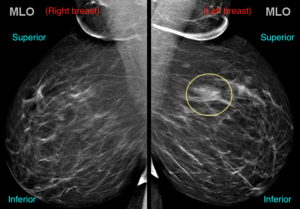
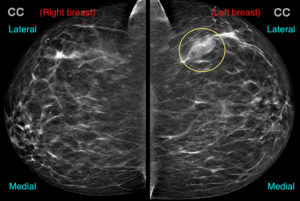
What is your assessment and recommendation after reading the screening mammogram?
A. BI-RADS 0 (Incomplete); Recommend diagnostic ultrasoundB. BI-RADS 1 (Negative); Recommend one year follow-up
C. BI-RADS 2 (Benign); Recommend one year follow-up
D. BI-RADS 3 (Probably Benign); Recommend six month follow-up
E. BI-RADS 4 (Suspicious); Recommend biopsy
Explanation: This is the patient’s first (baseline) mammogram and there is a left breast mass in the upper outer quadrant that needs further characterization before deciding final management. Targeted diagnostic ultrasound is the correct next step.
The ultrasound of the expected position of the mass is performed. A representative image:
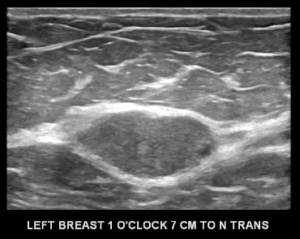
What is your assessment and recommendation?
A. BI-RADS 0 (Incomplete); Recommend diagnostic MRIB. BI-RADS 1 (Negative); One year follow-up
C. BI-RADS 2 (Benign); One year follow-up
D. BI-RADS 3 (Probably Benign); Six month follow-up
E. BI-RADS 4 (Suspicious); Ultrasound-guided biopsy
F. BI-RADS 5 (Highly Suspicious); Ultrasound-guided biopsy
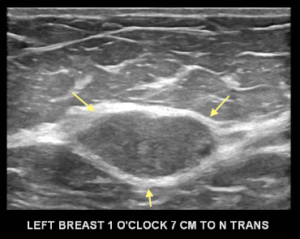
Explanation: This non-palpable, solid, circumscribed oval mass can be assessed as “Probably Benign”, meaning that it has a less than a 2% chance of being malignant. The assessment of BI-RADS 3 can be given with a recommendation for short term follow-up (diagnostic ultrasound in six months). Once two years of stability has been documented for this mass, it can finally be designated benign with no specific follow-up needed.
As per the ACR BI-RADS manual 5th edition, there are three mammographic findings which can be designated as BI-RADS 3, Probably Benign:
- A solid mass which is non-palpable, non-calcified, circumscribed, oval or round (as seen in this case).
- A non-palpable focal asymmetry with no ultrasound correlate.
- A solitary group of punctate calcifications.
Maybe you were wondering about the smaller mammographic mass that is posterior to the dominant mass. Here is the ultrasound of that second mass:

What is this mass?
A. CystB. Hamartoma
C. Lymph Node
Explanation: This is the normal sonographic appearance of an intramammary lymph node, with a thin hypoechoic cortex and a hyperechoic fatty hilum.